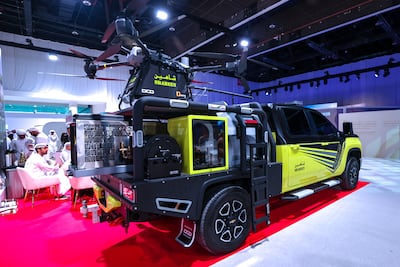From using drones to help extinguish fires and searching for people trapped under rubble in disaster areas to sonar scanners that pinpoint bodies underwater, the UAE is embracing emerging technology in its crisis response efforts.
The Emirates is stepping up its use of AI to help improve its response to emergencies, while the use of drones in the sector is also expected to increase significantly across the world, a senior figure from the National Emergency Crisis and Disaster Management Authority (Ncema) said.
Dr Saif Al Dhaheri, director of the National Operations Centre at Ncema, was speaking at the World Crisis and Emergency Management Summit in Abu Dhabi, which began on Tuesday.
“Drone usage in disaster response is expected to increase twenty-fold by 2028, while 70 per cent of emergency decisions will be AI-supported by 2030,” he said, referring to the use of technology in global search and rescue efforts.
Delegates from 30 countries were taking part in the summit, which brings together decision-makers and experts on search and rescue efforts on how best to respond to emergencies.
“The summit is an international hub to shape the future and strengthen international co-operation,” said Sheikh Nahyan bin Mubarak, Minister of Tolerance and Coexistence, in a speech on Tuesday. “The discussions in the summit will inspire new ideas for helping our emergency systems to support safety and stability in our societies.
“This summit is a testament to a scientific vision for a United Arab Emirates that is committed to saving lives and preserving communities, not only in this country but also in the region and the world.”
A brave new world
This year’s summit, held at Adnec, focuses on global resilience, strategic foresight and enhancing partnerships among governments, international organisations and the private sector. Technology used by emergency response teams in the UAE was showcased on the opening day.
Dubai Civil Defence exhibited its latest drone, Shaheen, an AI-powered, aerial firefighting system designed to handle blazes in high-rise buildings. Brig Suleiman Al Bloushi, director of the technical affairs department, told The National the drone has already been used this year to put out fires.
“The drone soars to a height of 200 metres, equivalent to 35 floors, in a few seconds,” Brig Al Bloushi said.

“It helps to extinguish fires in balconies and cladding. It is able to spray a mix of water and foam up to 25 metres from its 1,000-litre tank."
The Ministry of Civil Defence presented the AquaEye sonar device that can search for bodies underwater. The hand-held gadget uses AI to search depths further than were previously possible.
“The device can identify if there is a dead body under the water,” a representative from the ministry told The National. "It can scan one acre in less than two minutes."
Dubai Police showcased technology that played a vital role in helping find survivors in the earthquake that shook Syria and Turkey in February 2023. One of the devices on display works by being placed on rubble and making thermal scans to detect signs of life.
Another device, called the Life Detector, can also be placed on rubble to detect any noise made by somebody trapped under the debris of a collapsed building.
Rescue efforts
The UAE has helped with a number of high-profile search and rescue operations overseas. On Sunday, The National reported how a team from the Emirates had been praised for its efforts in helping with the response to the earthquake in Myanmar late last month.
The Myanmar government on Sunday honoured the UAE search and rescue team in a ceremony hosted by Dr Soe Win, the country’s Minister of Social Welfare. The emergency team was directed to provide support by President Sheikh Mohamed.


